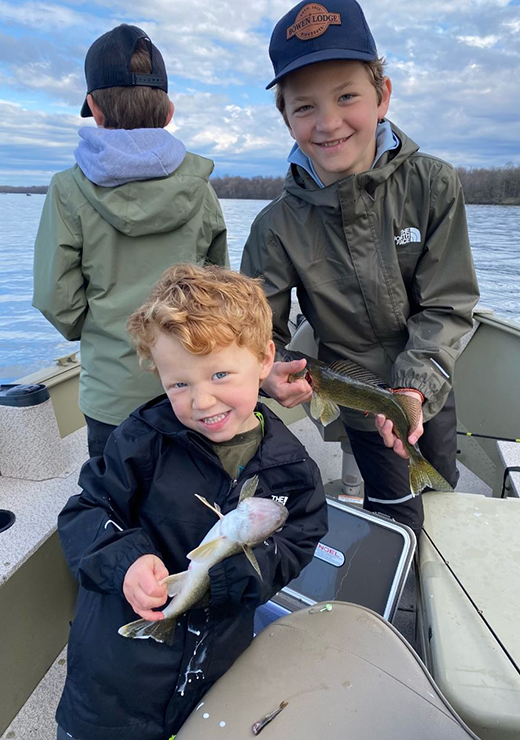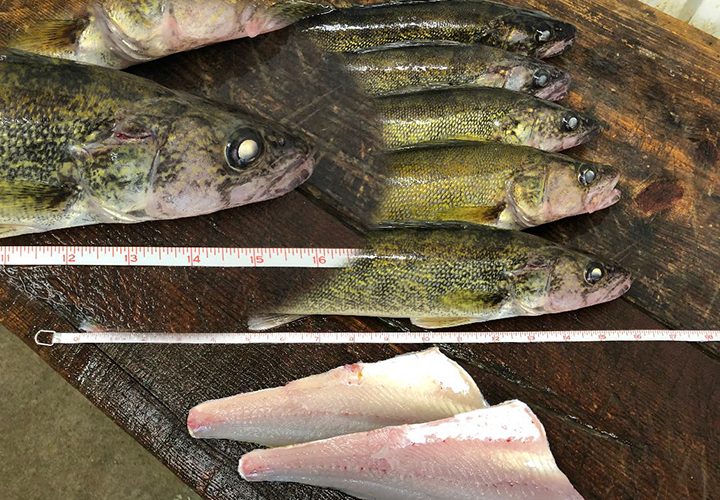The Memorial Day Weekend is upon us. It’s a hectic time but is super rewarding too because it often coincides with the peak of spring walleye activity. This year, our arriving guests will find walleyes active, and in the very early stages of transition between spring and early summer peak patterns.
Bowen Lodge guests catching walleyes with Jared
Shiner minnows, in their spring spawning runs, arrived on the shoreline in good numbers this week. For our guests, it means that shiner minnow supplies will be good, now available for anyone who wants them. For hungry walleyes, it means staying close to the shoreline to take advantage of the prime food source. Pike and perch love the shiners too, so don’t be surprised if you have random encounters with them during your search for walleyes.
Water levels are high and surface temperatures on the lake remain low. On Thursday, calm seas, combined with bright sunshine warmed the surface water to 56 degrees on Lake Winnie. Cutfoot Sioux, Little Cutfoot Sioux and select “back bay” areas of the big lake were warmer; 57 to 59 degrees could be found. when the winds blow and the waters re-mix, the true water temps will probably settle in somewhere between 53 and 55 degrees.
Water clarity varies around the lake, it now ranges between mildly murky, to ultra-clear. Walleye location, influenced greatly by water clarity, is strongly dependent on where anglers are fishing. We’ve had reports, on the same day, of anglers catching fish in shallow water while others report catching fish in deep water. That means you should be keenly aware of the conditions and adapt your fishing presentation to the water clarity in the immediate area you’re fishing.
On the north and west sides of Winnie for example, conditions are clear, and anglers are catching walleyes in the 22-to-28-foot depth range. Near areas with inflowing water, take the southeast corner for example, water clarity is much lower, anglers there are catching fish in water depths of 6 to 14 feet. The depth range varies with wind conditions, move shallow when the winds are strong, deeper when its calm.
Arriving later than usual, spawning activity of shiners, and other small baitfish has most walleyes keying in on minnows as their prime source of prey. So, jigs and minnows continue to make up 90% of the presentations that anglers are offering. The remaining 10% are divided between Lindy Rigging, slip floats and trolling spinners, all still using live minnows as the primary live bait.
It should be noted that the term “deep water” currently refers to structures adjacent to, or nearby the shoreline. They will produce much better results than deep water located in the lake’s mid-section. Main lake bars like the Bena Bar, Horseshoe and Sugar, that connect directly to the shoreline have begun producing some fish. But most of those fish remain in transition and could easily be found back up on the shoreline when the winds blow just right. Mid-lake structures, isolated bars and humps have not yet seen the arrival of fish moving into summer patterns.
Leeches may work but reports of shortages may mean that sticking with minnows is a smarter choice anyway. Night crawlers, more readily available, should be carried in your boat, experiment with them when conditions are ultra-calm and fish activity is sluggish.
Glow-Blue, Glow-Perch, Chartreuse Yellow and Green are all good color choices right now. Best jig weights are 1/8 ounce for shallow water fishing, ¼ to 3/8-ounce sizes for fishing the deep breaklines.
Moving deeper is one way to combat calm, sunny conditions. But another pattern worth mentioning is fishing the twilight bite. For anglers who fish at sunset, walleye activity has been very strong, between 7:30 and 9:30 PM, walleyes are cruising shoreline areas and feeding aggressively. Jig and minnow presentations work well, but some anglers, trolling crankbaits are doing well too.
Perch have begun to show up, but not in great numbers. Most are caught by walleye anglers, a few are caught by folks who target them specifically. If catching perch is your goal, deep water is reportedly better than shallow water. Focus on the transition from sand to soft bottom in water depths of 24 to 28 feet. Use jigs, Lindy Rigs, or slip floats and tip your hooks with lively minnows; medium to large fatheads will work best.
It's still too early for crappie or sunfish to move shallow. Until the terrain begins to green up and waters warm into the low 60s, any panfish activity will be found deep during the day, or along the shoreline during late evening. Slip floats, small jigs and small to medium size fatheads will catch crappies. Get in position at water depths of 6 to 8 feet, located along the shoreline before 8:00 PM. Crappie feeding runs will begin shortly after that and continue for about 45 minutes. This spring, crappie anglers are picking up more “bonus” walleyes than usual too.
Northern pike have not been the target species for many, and most have been caught by walleye anglers. The size range has been small so far, we expect to see more and larger fish at water temperatures rise and vegetation emerges.




















